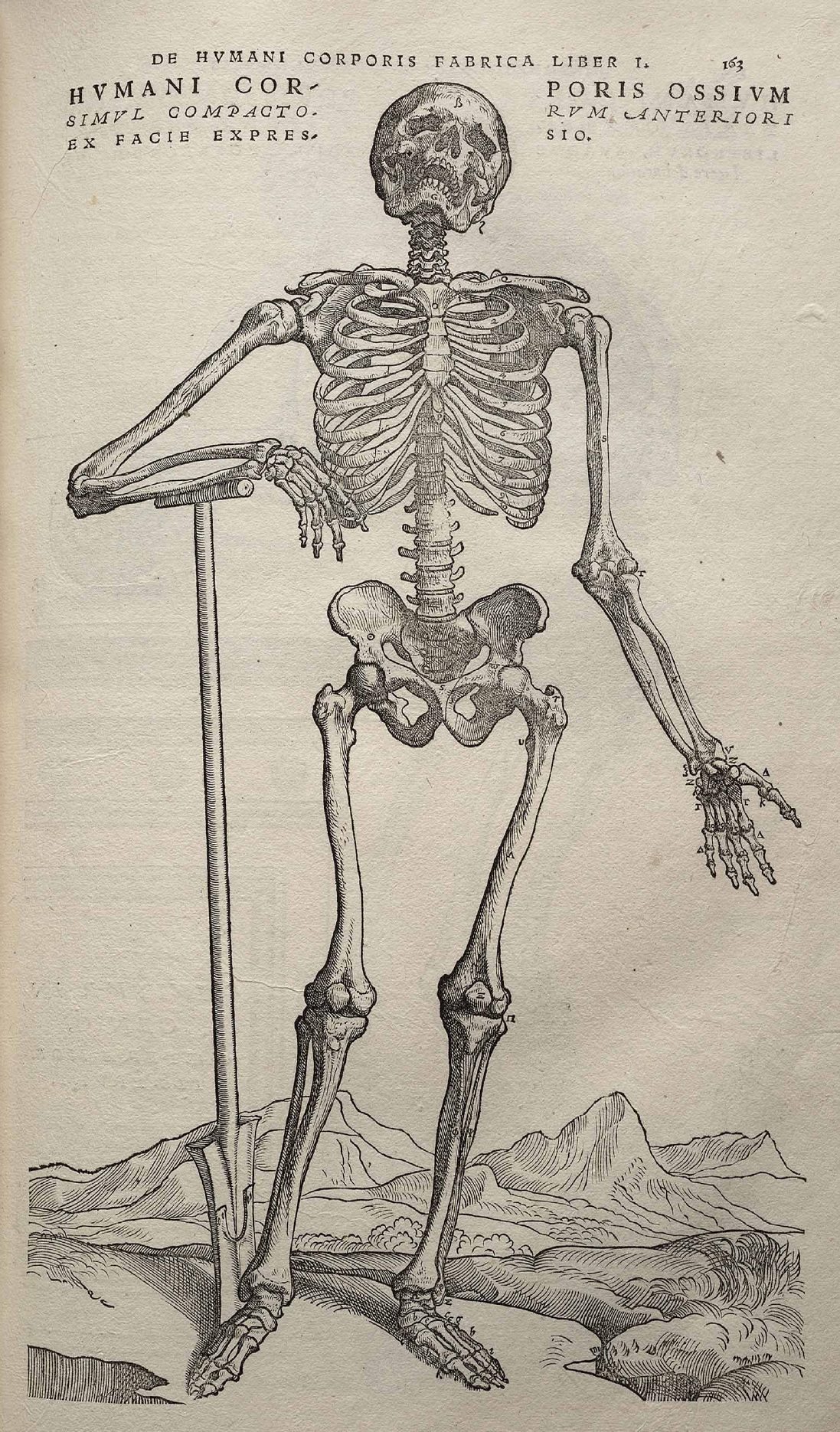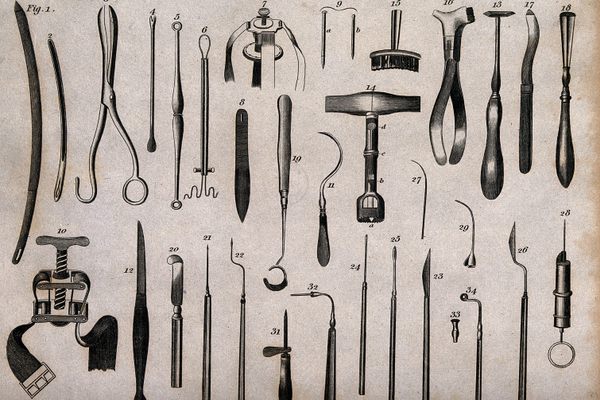The Gruesome History of Making Human Skeletons
From quicklime to boiling to bugs.

Here are some instructions for preparing human bones for display, from circa 1543:
Step 1. Acquire a corpse. No, no hints about where or how. You’re on your own there.
Step 2. Cut away as much flesh as you can. Watch the joints and ligaments—you need those intact.
Step 3. Acquire a body-length box, with holes in the walls. Place the bones inside, and cover with quicklime (used for centuries in agriculture, warfare, and cemeteries, and now available online). Sprinkle with water and wait a week. Presumably, leave the box someplace where no one will accidentally open it.
Step 4. Locate a stream or other body of running water in which to place the box. Give it a week, to allow the stream wash away the now loose and decaying flesh.
Step 5. Clean off any leftover flesh, and leave the skeleton to dry in the sun. The ligaments should keep the bones together.
There—your very own human skeleton.

If you find this set of instructions foul, so did Andreas Vesalius, the 16th-century author from whom they’re derived. Vesalius was a hotshot Renaissance scientist with a talent for self-promotion. He was young, cocky, and skeptical of the medical establishment, which was still reliant on ancient Greek medical work that was already more than a millennium old at the time. In Vesalius’s opinion, skeleton-making was “time-consuming, dirty, and difficult,” according to Oregon State University historian Anita Guerrini.
He preferred a different strategy for revealing human skeletal anatomy. First, boil the body in a “capacious cauldron,” then skim away the fat and clean the boiled flesh from the bones. That way, you could actually see the joints, instead of leaving them hidden behind blackened ligaments.
“Now most of the skeletons used in medical schools are plastic, but the ones that were used a couple hundred years ago—they were all people,” says Guerrini. For centuries human skeletons have been bought and sold, though it’s rare for a commodity to have once been part of a person. But despite the long practice of hanging human bones in museums and academic institutions, “we really don’t have a good history of skeletons,” says Guerrini. After noticing how overlooked they had been, she began investigating the history and iconography of skeletons—how they were they used, how they were made, and how that knowledge was passed down through generations of scientists. Vesalius’s technique was one among many proposed strategies for creating a pristine set of human bones.

Vesalius’s description is the oldest-known set of such instructions, but by the 1540s, the practice had been around for some time, perhaps going as far back as the 1300s, as Guerrini recounted in a talk at Columbia University this past September. One 14th-century scientist, for instance, mentions “making an anatomy” from fleshless bones.
Vesalius became a professor in Padua, as chief of surgery and anatomy, in 1537, when he was just 23 years old, and he wrote De humani corporis fabrica (On the Fabric of the Human Body), which contains the skeleton instructions, before he turned 30. “He was brilliant, and he was very brash,” says Guerrini. His book, unusually, had a portrait of himself on the title page, and another on the frontispiece. While his older colleagues deferred to the medical works of Galen, the Greek physician who lived in the 2nd century, Vesalius preferred direct observation of the human body. He taught using dissection and seemed to have no qualms about using human remains. “With characteristic macabre whimsy he recommended posing the skeleton with a scythe, or a pike, or a javelin, and suggested stringing the ear bones onto a nerve to make a necklace,” Guerrini said in her talk.
He didn’t care much about the aesthetics of the bones themselves, though. The boil-and-carve strategy he advocated for would have left the bones mottled and brown. As skeletons became more popular as objects of display and learning, their appearance became more important.

They remained rare objects, though, until the 17th century, when the new science of osteology, the study of bones, increased their use in anatomical study. By the middle of that century, skeletons, both human and animal, started showing up in the catalogues of natural history collections and cabinets of curiosities, such as the elaborate, skeleton-filled dioramas built by Dutch anatomist Frederik Ruysch.
Soon students of both art and anatomy were expected to study human skeletons as part of their training, and the public grew curious as well. By the 1660s, there was a market for them in Europe. By the 18th century, displaying human skeletons became trendy. Guerrini found a 1716 advertisement for “The Moving Skeleton,” a public attraction “which by a mechanical projection performs several very strange and surprising actions, also groans like a dying person, smoaks[sic] a Pipe of Tobacco, and blows the Candle out, as naturally as if alive.”
By this time, anatomists wanted to produce clean, white bones. One physician made sure to leave his bones out for months to bleach in the sun. Another eschewed boiling bones and instead left corpses to rot in water, changed periodically. This “maceration” technique required pulling softened flesh away from the bones and would have required a steely constitution. But the demand for skeletons was high enough that more people were taking on this job: In the early 18th century, one surgeon offered a course in skeleton-making.

While researching this history, Guerrini found that, some time in the 200 years after Vesalius, anatomists became more circumspect about their habit of stripping corpses of flesh and putting it on display. Vesalius, with his ear-bone necklace and artfully posed skeletons, was boastful of his work. By the 18th century, anatomists were less eager to crow about it. Alexander Munro, an expert in osteology, wrote a whole book on bones without ever once mentioning how to make a skeleton. William Hunter, a generation later, told his students that they should acquire a skeleton for personal use, but never published his lecture notes explaining the process of creating one.
“I was struck by Hunter and Monroe’s aura of secrecy,” says Guerrini. “Looking at Hunter, in particular, he never published his anatomy lectures.” The only reason she knows about his skeleton how-tos is that his students took notes, and those notes are still in archives, hidden away from public view.
There is something eerie about the instruction that all, say, 30 students in an anatomy class should somehow acquire their own human skeletons. Hunter, Guerrini says, never specified where they were to find bodies, but students likely would have had to resort to grave-robbery, “resurrection men,” or bribing gravediggers or hospital workers. (Hunter’s brother was apparently an ace at body procurement.) Attitudes toward death had been changing in Europe, and the idea of a carving up a not-insubstantial number of bodies and selling their bones started to seem distasteful, even morally reprehensible. While Vesalius could joke about the fate of these bodies, “William Hunter acknowledged the ‘necessary inhumanity’ of dissection,’” Guerrini says.
That didn’t stop him from offering his own new-fangled techniques for skeleton-making. Like Vesalius, Hunter had strong opinions about the best strategies. “If you want the Bones to be white inject by the Aorta for two or three Hours which will return by the Veins,” he wrote, without specifying what, exactly, should be injected. “Then expose them to maggots.” Or, if you had enough time, you could simply bury a body in a box by an anthill. It was, at least, a less hands-on method of stripping flesh from bones.

























Follow us on Twitter to get the latest on the world's hidden wonders.
Like us on Facebook to get the latest on the world's hidden wonders.
Follow us on Twitter Like us on Facebook